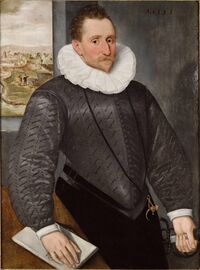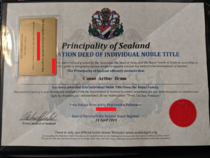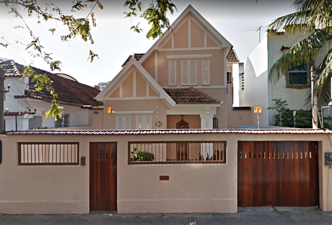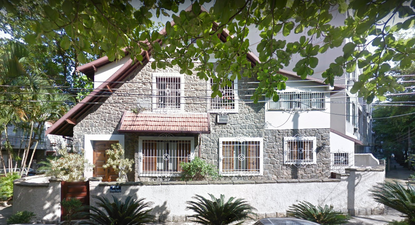House of Bruyn
 | |
| Country | (present-day Countries in which the House of Bruyn holds nobility or royalty status |
|---|---|
| Parent house | Clan Drummond (Cognatic) |
| Titles | Current:
Royal and noble titles Former: Royal and noble titles |
| Founder | Gillis van der Bruyn (first known surname user) |
| Current head | HE Armando, 5th Baron of Roches |
| Founding | 1449, Bruges, County of Flanders, Burgundian Netherlans |
| Deposition | In Roschfallen 29 December 2019 In Harram 8 August 2021 |
| Cadet branches | Bruyn-Harram Bruyn-Carvalho |
| Ethnicity | White Latin Americans |
| Ebenthaler royal family |
|---|
 |
Extended royal family HLH Prince Marius George
HRH Prince Maurice
HLH Prince Mauro
HRH Princess Neide
HRH Princess Luzia
HRH Princess Fatma
HRH Princess Sandra
HRH Princess Heloise
Descendants of HE Henrique, 3rd Baron of Roches:
|
The House of Bruyn (Portuguese: Casa dos Bruyn; /brˈüɴ/) is a Portuguese-Brazilian noble family of Dutch origin and the reigning royal house of the Kingdom of Ebenthal, Sultanate of Harram and the Duchy of Marienbourg, as well as the former reigning house of the Kingdom of Roschfallen and the Sovietian Empire. The House of Bruyn also enjoys a noble status in many countries such as Portugal, Karnia-Ruthenia, Sealand, Sildavia, Quinta Velha and Lifréia, and exercise or has exercised political influence in Vishwamitra, Schneeblutig, Lateran State, Achsen, New Southern Rhine, Manso and Baustralia.
The house is believed to have its origins as least in 1449 between the County of Flanders, in modern-day Belgium, and the lordships of East Frisia, in modern-day Germany. The Portuguese-Brazilian branch of the family is a cognate descendant of Clan Drummond, a family of high Scottish nobility closely related to the House of Stuart. The Bruyn family settled in Portugal around 1520, where they became fidalgos and were ultimatelly ennobled in 1871 by King Luis I. Between the beginnings of the 19th and 20th centuries, the family permanently settled in Brazil. From 2014 the House of Bruyn became a royal house by rising the thrones of successive secessionist micronations in South America, developing into one of the continent's most prominent [albeit micronational and thus unrecognized] royal houses, as well as within the Brazilian micronational, heading five monarchies.
Etimology
Bruyn is a Dutch surname, itself a derivation of the Dutch word Bruin, translated to "brown". The family name is supposed due to their typical brown hair, but it could also be due to dirty brown clay hands, given the family's history as artisans. Members of the family are called van der Bruyn. As the family spreaded to different countries such as Portugal, England and Germany, surname variations begun to appear such as Braun (German), Brown (English) and Brum (Portuguese).
History

Origins
The Bruyn family has its known origins disputed between the Duchy of Brabant, a state of the Holy Roman Empire at the Burgundian Netherlands, where the aristocrat Anton van der Bruyn,[1] the first bearer of the family's surname whose history in known in some depth, was born in 1460. Little is known of his own origins, but some sources appoint that his family came from the County of Flandres,[2] as the archives of the town of Schouteet mention a Gillis van der Bruyn, head of the Artisan Guild from Bruges in 1479 [when he was aged at least 30]. Sources also claim that originally the Bruyn family emerged in East Frisia,[3] eventually settling in Flanders. In the late 15th century, Anton van der Bruyn married to Margot Sabuya, an aristocrat member of the Italian House of Savoy. Their son, Wilhelm van der Bruyn (1493?-1553), moved to the Portuguese archipelago of Azores[1] at the first decade of the 16th century (or around 1480), becoming a sugar trader. There he met Violante Vaz de Ferreira Pimentel (born in 1495), daughter of the first Captain-Donator of the Azores and matrilineally either granddaughter or great-granddaughter of Sir John Drummond V (1400-1465),[1] member of the Clan Drummond of Scotland, son of Sir John Drummond of Stobhall, 12th Thane of Lennox (1356-1428), himself a brother of Annabella Drummond, Queen consort of the Scots (as wife of King Robert III of the Scots), nephew to Margaret Drummond, Queen consort of the Scots and uncle to King James I of the Scots.
Portugal and Brazil

In the Azores, Wilhelm and Violante fathered four children: António, Cosme, Catarina and Caspar, among which António and Catarina continued an aristocratic lineage by marrying respectively to Lady Barbara van Aertrycke and Lord João van Aertrycke, children of the Dutch aristocrat Josse van Aertrycke, who had fled the poverty of the Burgundian Netherlands following the Hundred Years' War and the bad politics of Philip the Good to the still wild Portuguese archipelago of the Azores to undertake in maritime trade, and grandchildren of Willem van der Haegen.[1] While António's offspring came to be among the first to colonize the Madeira Island off the coast of Africa, Catarina's offspring remained in the Azores and in the early 19th century some of her descendants started to immigrate to Brazil,[citation needed] where there were already other Bruyn descendants of Catarina's brothers since the 18th century - many immigrated following the Transfer of the Portuguese court to Brazil in 1807.
In 1871, still in Portugal, Simão de Roches da Cunha Brum [van der Bruyn], a commercial investor in Azores and Madeira and a direct descendant of Catarina, was created Baron of Roches by King Luis I. Following Simão's death, in 1901, King Carlos I confirmed the inheritance of the title, in way that Simão's eponymous son succeeded him as 2nd Baron of Roches. Simão II had no children, but he had a large estate to be inherited, and in 1907 he adopted his closest relative, his nephew, the Brazilian-born Henrique Ignácio van der Bruyn, son of his late half-brother Bernardino Ignácio van der Bruyn, as his son. Thus, on his deathbed in 1934, Simão's titles and property passed to his nephew and legal son, Henrique, who became the 3rd Baron of Roches. Eventually Henry liquidated the remaining Bruyn holdings in Portugal. He was succeeded on his title by his older son Mário, 4th Baron of Roches, in 1950, and Mário by his only son from a legal marriage in 1992, Armando, 5th Baron of Roches, current head of the Portuguese-Brazilian noble branch of the Bruyn family.[citation needed]
Micronational history

Roschfallen and Schneeblutig
In 2014, Arthur van der Bruyn, the only son of Armando, the 5th Baron of Roches, founded the Kingdom of Roschfallen, an independent secessionist micronation, assuming its throne as Arthur I. He ennobled all his immediate family (mother, sisters, nephews and nieces) as Princes and Princesses of Roschfallen, granting his father the special treatment of Serene Highness while his older sister and heir, Élida van der Bruyn, was granted the title of Princess of Iriland. Arthur chose not to give his father a Roschfallenian title in order to not jeopardize his claim to a noble title of a recognized country, Portugal.
In 2016, watching the dormant Schneeblutigan Empire, Arthur claimed that country's government with no resistance, but instead of proclaiming himself as Emperor, as most members of his government intended, he chose to establish himself as a regent, recognizing the formerly reigning house's legitimacy, and claimed the title of Prince Imperial with the treatment of Imperial Highness awaiting for the rightful Schneeblutigan monarch to take the throne. By doing this, he also became the heir to the throne of Schneeblutig. Eventually in 2019 he gave up the claim, and in 2020 he recognized King Pedro I's, Schneeblutig's former Emperor, return to that throne.
In 2017, despite of still occupying the throne of Roschfallen, King Arthur [van der Bruyn] joined the Liberal Party of the Kingdom of Manso and subsequently served as Minister of Foreign Affairs of that country and later as Senator, having been ennobled Marquis of the Water Valleys by Queen Marina I.
Arthur II and Ebenthal

Caught in a political crisis, Arthur abdicated the Roschfallenian throne on 29 December 2019 as soon as he was invited by Raphael Sousa, Regent of the Kingdom of Ebenthal, to assume that country's throne. Along with his title, Arthur relinquished all of his family's Roschfallenian royal titles and withdrew all of his immediate family's properties from that kingdom. Upon assuming the Ebenthali throne, his sister Élida was declared his heir once again under the new title of Princess of Belmonte with the treatment of Illustrious Highness, while this time all of his family members making use of the Bruyn surname were made Princes of Ebenthal. Though, in 2021 Princess Élida resigned her title of Princess of Belmonte and her place in the line of succession in favor of her son Heitor van der Bruyn.[4] A law was passed returning the princely title of Belmonte to the Belmontine Princely Family and severing the link between the title and the heir to the Ebenthali throne. Prince Heitor then became the heir to his uncle's throne with the new title of Prince of Altenburg.[4]
On his birthday in 2020, the now King Arthur II of Ebenthal was gifted the title of Count of Sealand, while in April that year he relinquished his title of Marquis of the Water Valleys, granted to him by Queen Marina I of the Manso, over a feud with that monarch and her government. In July that same year, Arthur became Emperor of the Sovietian Workers upon founding the Sovietian Empire, a unique micronational project he had in mind for ages, and in August he was made Prince of Engern-Tonna in Karnia-Ruthenia, with hereditary rights, thus making of the House of Bruyn a higher noble house in Karno-Ruthenian peerage.[5]
In 2021 Arthur II was made Duke of Daman in Vishwamitra as well as Duke of Zëgret in Sildavia, but the most relevant event for the house that year properly was its ascension to the throne of the Sultanate of Harram through a coup d'état which established Prince John of Ebenthal as Sultan Hassan III of Harram, thus becoming the second member of the House of Bruyn to seat in a throne. Nonetheless, Hassan's reign last little since he was deposed by the same people who installed him, including his cousin the King of Ebenthal.[6]
Influence on politics
In late 2020 Arthur II was appointed Regent of the Hanseatic and Confederate States of Achsen and was tasked with the political organization of the country, including the formation of a government that could replace him and bring about the coronation of a monarch. He kept the office from 10 December 2020 to 10 July 2021. In early 2021 Arthur II was also responsible, through the Conference of Santiago Derivative Program, for the creation of the Independent State of the New Southern Rhine, which he handed over to the Ebenthali Parliament leader, Jonathan Scherer. who became King of New Southern Rhine.
In the second half of 2021 Arthur II and his main ally Oscar I of Karnia-Ruthenia entered into a tripartite agreement with the King of Roschfallen (who succeeded Arthur on that throne) whereby Roschfallen would formally become part of Karnia-Ruthenia's sphere of influence, as the Lateran State, would separate from that country, becoming again a sovereign state and Ebenthal's puppet. Nonetheless, in July 2022 the Roschfallenian government offered the throne to Arthur's nephew, Prince Theo of Ebenthal, who declined it.
Armorial

The House of Bruyn's coat of arms consists in a white field with a red stripe charged with three golden fleurs-de-lis; above the stripe, three golden partridges; over the shield a helmet representing the family status as fidalgos of the Portuguese Royal House, with the Portuguese baronial coronet representing the family's two Portuguese titles, that of Barons of Alagoa, granted in 1841 by the Queen Maria II, and that of Barons of Roches, granted in 1871 by King Luís I and later confirmed in 1901 by King Carlos I.
The Royal Family of Ebehthal, of the cadet branch of Ignatio-Savoy-Bruyn, uses an English shield divided into four quadrants as their coat of arms; on the first and fourth quadrants there is the coat of arms of Ebenthal; the second and third quadrants are identical, each divided into four quadrants: in the first, the coat of arms of Clan Drummond, in the second and third, of the House of Savoy, in the fourth, of House of Bruyn.
The Sultanic Family of Harram uses a red Polish shield with the Shahada written in white, topped by a star and crescent. The coat of arms is never presented in its lesser or single form, rather being presented accompanied by six red flags with the star and crescent, three on each side of the shield which is surmounted by the Sultanic Crown; below, a golden frame supports the shield and bears the star of the Order of Hassan the Great.
The Ducal Family of Marienbourg uses as coat of arms the exact same as the Ebenthali Royal Family except that the lesser arms of Marienbourg are added to the center of the coat of arms of the House of Bruyn.
| Coat of arms | Title | Tenure | Coat of arms | Title | Tenure | Coat of arms | Title | Tenure |
|---|---|---|---|---|---|---|---|---|
 |
King of Ebenthal | 2019–present |  |
Duke of Marienbourg | 2022–present |  |
Sultan of Harram | 2021–present |
Estates and properties
The House of Bruyn owns and lives in a series of palaces, castles, houses, apartments and complexes throughout Brazil and in the countries where the family reigns. Among them, there is:
- Bubbington Palace, Malmünd; residence to King Arthur II and the Prince Consort.
- Palace of Rochesburg, Malmünd; residence to the Baron of Roches, Princess Laura and Princess Sophia.
- Ignatius Castle, Malmünd; residence to the Princesses Laíze, Eleine, Alice and Lara and to Princes Theo and Lorenzo.
- Sanktherese Castle, Malmünd; residence to Princess Élida and Prince Heitor.
- Fernandine Complex, Minen; residence to most of the King's maternal relatives.
- Summer Palace, Nëbensee; summer residence of the Royal Family.
-
Palace of Rochesburg, Malmünd
-
Walls of the Sankthere Castle, Malmünd
-
Fernandine Complex, Minen
Ebenthaler royal family
The Ebenthaler royal family (Portuguese: Família real ebentálica) is the family of the King of Ebenthal. Additional Act 1-2019 amending the Constitution of Ebenthal states that the royal family is formed by the King, his consort, his parents and up to two generations below. In practice, it means that the current royal family is made up of the King, the Prince Consort, the father, sisters, nephews and nieces of the monarch. The same Act states that members of the royal house are all legitimate descendants of Henry van der Bruyn, 3rd Baron of Roches, great-grandfather of King Arthur II, who make use of the surname Bruyn. Some members of the royal family and house support the monarch in undertaking public engagements, such as Prince Pedro Henrique, Prince Theo and Prince Heitor.
Members
| Extended content |
|---|
|
Harranian sultanic family
The Harranian sultanic family (Portuguese: Família sultânica harraniana) is the family of the Sultan of Harram. The Harranian monarchy, dating back from 2009 under the House of Harram. Following a coup d'état performed by King Arthur II of Ebenthal and Emperpr Oscar I of Karnia-Ruthenia, Prince John of Ebenthal was installed on the Harranian throne as Hassan III in June 2021 only to be overthrew in early August in favor of Hassan IV of Harram of the House of al-Fradiq. Nonetheless, after almost a year of reign, in August 2022 Hassan IV abdicated the Harranian throne and Hassan III was re-installed. According to the House Rules, the Harranian royal familu is formed by "the Sultan and his relatives". Legally, it is the Sultan's decision to define who the members of the royal family are, and traditionally it boils down to his next of kin. Upon beginning his reign in Harram, Hassan III created a cadet branch of the House of Bruyn which became known as the House of Bruyn-Harram.
Members
| Extended content |
|---|
|
Marienbourgish ducal family
The Marienbourgish ducal family (Portuguese: Família ducal marienburguesa) is the family of the Duke of Marienbourg. The Constitution of Marienbourg stipulates that the ducal family is made up of members of the Duke's maternal family, the Carvalho Family, under the leadership of the Duke, a member of the House of Bruyn, so that this family grouping is called the House of Bruyn-Carvalho. This degree of specificity is intentional due to the circumstances in which the Marienbourgish monarchy was established, through a treaty between Arthur van der Bruyn, ex officio King of Ebenthal, with two of his maternal great-uncles. Agnatically, the ruling house in Marienbourg is the House of Bruyn, to which the Duke belongs. However, considering that his maternal family owns all the lands of the duchy, this, and not the close relatives of the Duke, were constitutionally integrated as members of the ducal house. Recognizing this, the House of Bruyn in Marienbourg, under Arthur's authority as Duke of Marienbourg, adopted the name House of Carvalho-Bruyn, often referred to as House of Bruyn-Carvalho, honoring Arthur's surnames and order of surnames, Arthur Carvalho Ignácio van der Bruyn.
Members
| Extended content |
|---|
|
Ancestry
Ambilineal descent
Through an agnatic line to Catherine van der Bruyn (1522-1580) and matrilineal from her, the House of Bruyn descends from various European nobility and royalty through their connection to the Clan Drummond and the Clan Sinclair. Among the ancestors of the House of Bruyn are Charlemagne, Hugh Capet, William the Lion, Alfred the Great, Andrew I of Hungary and consequently Attila the Hun, Sigfried of Luxembourg, Gerolf of Holland, among others.
| Extended content |
|---|
|
Line to Attila the Hun
Line to Hugh Capet
Line to Ranulf of Aquitaine
Line to Gerolf of Holland
Line to Siegfried and Charlemagne
Line to the Saxons
Line to the Savoys
Line to William the Lion
Line to Alfred the Great
|
See also
• Monarchy of Ebenthal
• Monarchy of Harram
• Monarchy of Marienbourg
References
- ↑ 1.0 1.1 1.2 1.3 Claeys, André L. Fr. (2011). Vlamingen op de Azoren sinds de 15de eeuw, Volume II.. Bruges, Belgium. pp. 312–313. https://sites.rootsweb.com/~azrwgw/research-aids-a---l/azoren-ii.pdf. Retrieved 30 August 2021.
- ↑ "DEBOOMVANDESTOKERS". Retrieved 30 August 2021.
- ↑ Walcheren, Kringen (2010). Heerlijke rechten. Netherlands. https://www.meliskerke.info/images/pdf/Melis-Mariekerke.pdf. Retrieved 30 August 2021.
- ↑ 4.0 4.1 Ministry of Information. Ebenthal has a new crown prince. Published on 26 April 2021. Retrieved on 30 August 2021.
- ↑ Persenburg Citadel. Imperial and Royal Decree n. 197-2O2O, O1 August 2O2O. Retrieved in 07 August 2020.
- ↑ Hassan IV (9 August 2021). "Preskribo 01 - Ratifante Interkonsentojn". Retrieved 30 August 2021.
House of Bruyn Cadet branch of the Clan Drummond
| ||
| Regnal titles | ||
|---|---|---|
| Preceded by House of Beato |
Ruling House of the Kingdom of Ebenthal 2019–present |
Succeeded by Incumbent |
| Preceded by None Throne established |
Ruling House of the Kingdom of Roschfallen 2014–2019 |
Succeeded by House of Degani |
| Preceded by House of Basilio as reigning house |
Acting Ruling House of the Empire of Schneeblutig 2016–2019 |
Succeeded by Interregnum and then House of Basilio |
| Preceded by None Throne established |
Ruling House of the Sovietian Empire 2020–2022 |
Succeeded by House of Chalegre |
| Preceded by House of Harram |
Ruling House of the Sultanate of Harram Under the name of House of Bruyn-Harram 2021 |
Overthrew by the House of Al-Fradiq |
| Ruling House of the Sultanate of Harram Under the name of House of Bruyn-Harram 2022–present |
Restored following the abdication of Hassan IV al-Fradiq | |
| Preceded by None Throne established |
Ruling House of the Duchy of Marienbourg Under the name of House of Bruyn-Carvalho |
Succeeded by Incumbent |



